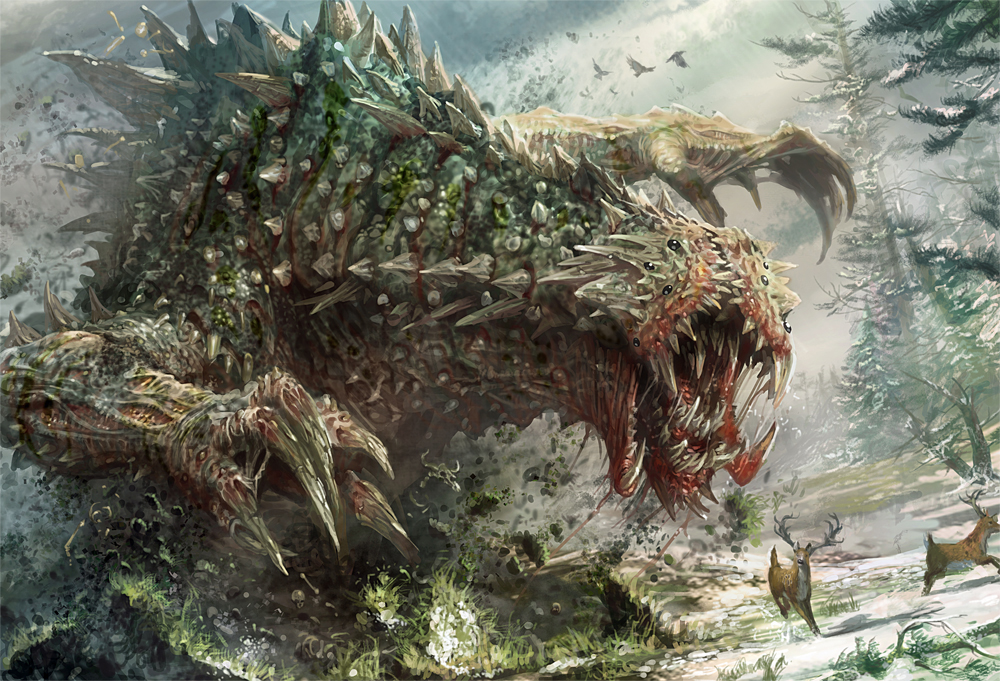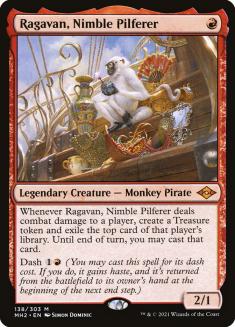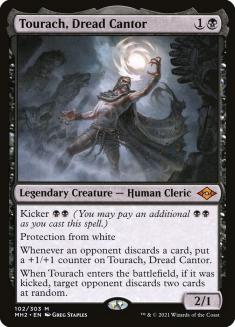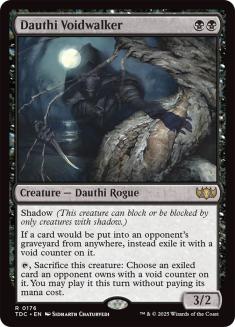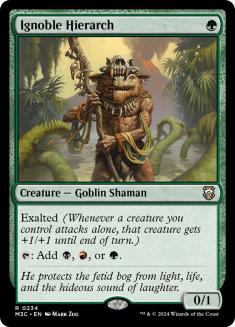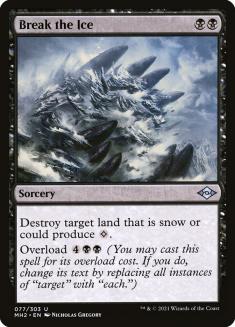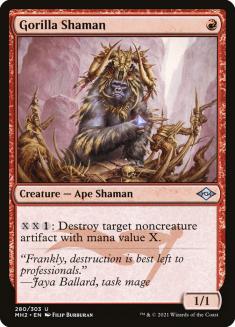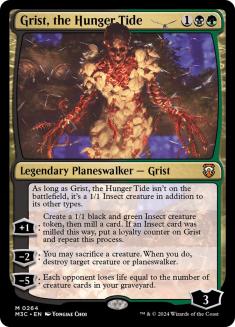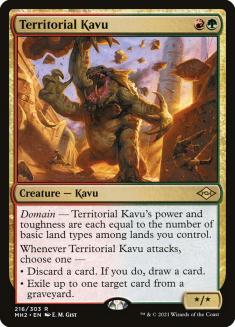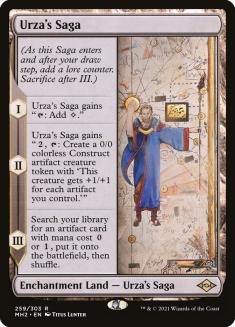The initial results after the release of Modern Horizons 2 are starting to pour in. As expected, it is making a large impact. The iteration towards finding the first “broken” deck of the format is fast and aggressive. I’d feel a bit awkward entering that arms race so quickly, given my participation with the set. Still that doesn’t mean I don’t want to get involved.
Where I do feel a lot more comfortable is taking some of the more fair tools and decks and seeing how they evolve with the ever-changing metagame. I’ve spent time browsing on Twitter and peeking at streams to see what folks are up to. Today I’ll share an update to an old favorite midrange strategy for those who enjoy playing their interactive Modern.
I’m not exactly on the level of Brad Nelson’s Jund Guy (is that trademarked?), but I’ve been known to sleeve up a midrange deck or two in Modern, and have run with the trailblazers when it comes to Thoughtseizing folks over the years. Even though the narratives of the Modern community seem to simultaneously contain both “Jund Midrange is unplayable” and “Unban Splinter Twin” at all times, I’m at least going to put forth the effort into debunking the former today.

Step 1: What has Jund Midrange potentially gained?
This isn’t entirely comprehensive, but these tools made the most sense for me out of Modern Horizons 2.
There are a lot of cards. For now, I believe the bar for moving outside of Lurrus of the Dream-Den builds of Jund Midrange is high. Although the strength of Liliana of the Veil and Bloodbraid Elf is also high, the format has received a power influx and for now I think it best to keep the deck as lean as possible until the dust settles and we have an established metagame. Perhaps when the format’s linears get streamlined and more folks know what interaction to include, the format will slow down a tad and allow you to play the deep games that the aforementioned iconic Jund duo thrive in.
That said, Lurrus naturally gives Jund some free grinding power. I’s tough to get away from that without good reason. It also makes our job a little easier, crossing off the mythic Elemental Incarnation cycle and Grist, the Hunger Tide.
Step 2: Know Your Enemy
I’ll preface this section by reiterating again that Modern is in an absolutely ridiculous period of flux. That said, we’re starting to see a trend. It’s possible that the most format defining card, at least early on, will be Urza’s Saga.
Ari did a great job tackling Urza’s Saga from a high level. In practice the Saga has contributed to a variety of linears and offered potential for grinding power and as a toolbox answer-of-sorts to a variety of other linears. Like he made the case for, it’s both extremely powerful and broad. Still, to me at least, so far it’s unclear whether it’s a true villain despite its obvious power level.
So what decks are the Saga in and what’s been successful so far? Hardened Scales won one of the two Challenges this past weekend in the hands of our own Dom Harvey.
Creatures (20)
Lands (24)
Spells (16)
- 1 Power Conduit
- 1 Welding Jar
- 4 Ancient Stirrings
- 2 Throne of Geth
- 4 Hardened Scales
- 1 Animation Module
- 3 The Ozolith
Sideboard

Hardened Scales has long been a powerful linear deck that waxes and wanes in popularity in Modern. Zabaz, the Glimmerwasp and Urza’s Saga are a clear shot in the arm for both raw power and utility. Take a look at the clean sideboard hate package that can accompany Urza’s Saga. You’ll be seeing a lot of similarities amongst other decks.
While Hardened Scales is my current pick for “previous linear contender that got the biggest upgrade,” slightly edging out Amulet Titan — which functionally remains the same except gaining Urza’s Saga to provide redundancy to its namesake — the “Hogaak alarm” is currently sounding for some folks for this strategy (which is seeing dramatic and rapid iteration from streamers and folks getting results with the archetype).
Creatures (23)
- 4 Street Wraith
- 4 Ovalchase Daredevil
- 4 Feasting Troll King
- 4 Emry, Lurker of the Loch
- 3 Cauldron Familiar
- 4 Asmoranomardicadaistinaculdacar
Lands (22)
Spells (15)

Drew’s list, and most of the early lists (aka yesterday) of Asmor (please let this be an acceptable short-hand word) The Underworld Cookbook decks are interested in leveraging a lot of Food and using Feast Trolling King as their big threat. I particularly like that Drew’s list is using Metallic Rebuke and Trail of Crumbs as forms of interaction and grinding potential respectively.
The earliest list I saw was a Hollow One deck. It used the aforementioned Vengevine and even Bartered Cow for quicker beatdown.
Notable Modern innovator Do0mswitch has arrived at the following list as of the morning of June 7:
While perhaps not as explosive as the earliest lists, this is the one that concerns me more; his list looks like it can function as a powerful linear, but also has some nods to staying power and playing to the battlefield independently of being an all-in graveyard deck with Ragavan, Nimble Pilferer; Seasoned Pyromancer; and Smuggler’s Copter. I suspect that we’ll be seeing more evolution on this front.
A non-Urza’s Saga deck that’s getting love from Modern Horizons 2 and needs to be on our radar:
Creatures (22)
- 4 Magus of the Moon
- 2 Bloodbraid Elf
- 4 Shardless Agent
- 4 Seasoned Pyromancer
- 4 Bonecrusher Giant
- 4 Brazen Borrower
Lands (22)
Spells (16)
Sideboard

This is another strategy that’s undergoing rapid iteration by the day. Despite most of the tools previously existing, Shardless Agent is a big upgrade from having to splash additional colors to have the requisite cascade redundancy, and Fire // Ice is another huge pickup in terms of cheap interaction that conveniently doesn’t disrupt your cascade chain. Further, Otakkun put a huge emphasis on Blood Moon, playing the full eight with Magus of the Moon maindeck. The reason? Urza’s Saga instantly dies to these effects due to rules that I won’t pretend like I understand. This strategy has the unique advantage of being able to function like weak control in addition to linear combo. Blood Moon is excellent right now, so it needs to be on our radar.
Step 3: Put It Into Practice
There’s clearly a lot of emphasis on the graveyard and powerful linears in the format right now. Artifacts are a large component of the format, and we still need the ability to beat creature decks (including Humans, Blink variants, and Selesnya Company). Putting that all together, I’ll start with my list and then defend the choices.
Creatures (16)
- 4 Tarmogoyf
- 2 Kroxa, Titan of Death's Hunger
- 4 Ignoble Hierarch
- 2 Tourach, Dread Cantor
- 4 Dauthi Voidwalker
Planeswalkers (2)
Lands (22)
Spells (20)

Where’s the Monkey?
Normally this would be a section where I’d have to defend multiple omissions. By and large, though, this is just a section on Ragavan, Nimble Pilferer.
So, I think Ragavan sucks in this deck. At least for now.
This probably sounds silly, but I don’t think the powerful one-drop has much place in Jund Midrange for now. This isn’t a linear attacking deck, and the format is so strange at the moment with a bizarre mix of strategies that it’s very difficult to run away with a game using Ragavan’s card-exiling ability in the average matchup. Discounting that, what else does Ragavan bring? A 2/1 that can generate a Treasure is certainly powerful, but it’s easy for the creature to get brick-walled, and Jund Midrange just isn’t interested in playing a game where it’s priced into clearing the way for a one-drop creature to continue to attack. Jund Midrange needs to disrupt then turn the corner and attack their opponents down.
Also, frankly, folks just seem to be ready for him. I’m not Fatal Pushing Arboreal Grazer, Wall of Omens, or Cauldron Familiar just to hit for two.
Maybe this short paragraph hasn’t convinced you, but it feels like Jund Midrange needs to either shut out their opponent’s gameplan or wear them completely out of resources to have a shot right now. I believe it has the tools, but Ragavan doesn’t contribute to those two primary gameplans.
These three, of course, are the maindeck trio from Modern Horizons 2. I would be surprised if I had to make much of a case for how strong a Jund-shifted Noble Hierarch is, but even despite having a relatively low curve, Jund Midrange is often starved to use its mana for trading off resources as quickly as possible, and despite being a Lurrus deck we have plenty of ways to sink our mana. For starters, there’s the companion itself. Kroxa and Tourach are both secretly four-drops. Exalted does good work all around for pressuring opponents and winning Tarmogoyf wars.
Dauthi Voidwalker is probably the weirdest one. It’s a potent threat that gives you natural hate against a wide swath of the format (including Hardened Scales and and Food builds), while also building in bizarre nut draws. In some ways, Dauthi Voidwalker is like Ragavan’s ability; sometimes you really get them, but with Voidwalker, you can spike Turn 3 Primeval Titans or Crashing Footfalls (AKA dramatic game-ending effects).
Of course, the shadow creature can’t block effectively, which means that it’s a natural liability against decks like Humans and needs to get sideboarded out against most creatures and Burn decks, but the upside it has given the texture of the format as it stands is massive. It’s the centerpiece for how to build the deck right now, and of course is subject to removal as the format evolves.
I finally removed the last two Ragavans for Tourach, Dread Cantor. So far they have worked well. They give you a critical mass of disruption and allow you to cheat more top-end into your deck. The protection from white does a ton of heavy lifting against Humans and various Auriok Champion decks that your Dauthi Voidwalkers are such a liability against. Don’t sleep on this card.
The Sideboard
The elephant in the room: I’m playing Urza’s Saga as a toolbox enabler for various hate cards.
Frankly, it’s possible it should just be in the maindeck. Despite a modest amount of interactions, the floor of getting Mishra’s Bauble and being a functional couple of copies of a card like Nihil Spellbomb is pretty appealing. Its interaction with Wrenn and Six is extremely strong, and the two can represent a viable grindy game plan of Construct generation. Of course, the deck can be mana-hungry and it’s miserable with Kroxa, but this is still something to keep in mind for Jund and other midrange decks.
Yes, Urza’s Saga is that good. (Props to Patrick Sullivan for mentioning Pyrite Spellbomb as a means to fight Auriok Champion. That shit is sweet.)
Rounding out the sideboard of new options is Gorilla Shaman. Now this diamond-hands homie is particularly good at shotgunning down Food, and is passable at containing various Food generators, but I don’t exactly have a great sense of how acceptable the amount of mana investment here is relative to the Food deck’s offensive output. It’s also a useful tool against The Ozolith, but this might just be too weak. I’m cautiously optimistic on this one.
Otherwise, we’re basically just trying to diversify with additional removal. If Shaman sucks, then the second Collective Brutality returns to help with Burn/Prowess and the Cascade matchups.
It’s tough to go into specifics with how widely and rapidly things are changing. As mentioned previously, you want to remove Dauthi Voidwalker for removal spells against creature decks where its text isn’t relevant. Your hate package against the Food decks can easily replace Tourach and some of your discard spells. You want to be able to poke holes in their gameplan, but once they make it to the battlefield and establish their engine, your discard is worthless and you’ll need to react.
You’re situated fairly well against blue decks. You just want to make the obvious swaps of Veil of Summer when your removal spells are subpar, and as Jund Midrange does you’ll generally be trimming on your pieces that you don’t want to draw multiple copies when appropriate — hate, discard, and sometimes extraneous threats when you need to answer multiple types of problematic permanents.
If you’re drawn to Jund Midrange and have been down this road before, it will all mostly be familiar. The pain is just always in the details. There’s a lot to explore, but you could do a lot worse than taking a proven proactive strategy with some big upgrades and a splash of maindeck hate into battle against the emerging field of Modern Horizons 2.

